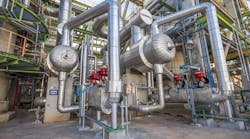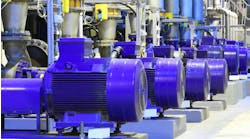Most motors in petrochemical plants are located in hazardous (classified) areas. The large majority of these motors are located in Class I, Div. 2 locations. Many times on the motor datasheets the engineer produces for purchasing a motor, it indicates a required T-Code for the maximum temperature allowed for the motor. Is this really required, and does it mean anything?
Actually, the answers are not as clear as you might think. The short answer is: T-Codes aren’t required for motors. And yes, providing a T-Code may help the motor manufacturer provide the right motor.
Although Sec. 501.125(B) of the NEC doesn’t specifically require a motor in a Class I, Div. 2 area to have a T-Code, you must consider the reference in Informational Note No. 1. It alerts the user that internal and external surface temperatures must be considered when placing a motor in a hazardous location. So why doesn’t the NEC just require a T-Code for all motors instead of putting a vague warning in an Informational Note?
The use of totally enclosed, fan-cooled (TEFC) motors in classified areas is common in voltages less than 600V. If an abnormal process condition exists, and combustible gases or vapors are released, then these hazardous gases can enter the motor enclosure and come in contact with the stator and rotor. So, it’s not just the warm surface temperature of the motor housing that must be considered as a source of ignition.
Unlike most equipment that has standard T-Codes, such as luminaires, motors are a different animal. Motor duty can vary. The motors may either be lightly loaded — producing relatively little heat, or they could be loaded greater than 100% of the rated horsepower or kW — thus producing more heat. The applied voltage may be unbalanced, or lower/ higher than the rated motor voltage, causing it to run hotter than it would if it were operated at its rated voltage. (Note: NEMA 3-phase, 480V motors are typically rated at 460V per NEMA MG-1, but can be run at 480V or more. For more information, see NEMA MG-1). In addition to across-the-line power, some TEFC motors are fed via a variable-frequency drive (VFD). Due to the harmonics generated by the VFDs, the motors can run hot. This is one reason if you’re specifying a motor for a VFD application it should be rated for VFD (inverter duty) service.
By the examples noted above, it’s obvious that even with the few variables mentioned, it would be very difficult to come up with a standard motor T-Code. That’s one reason why the NEC puts the onus on the design engineer to figure out if the motor will be too hot for the environment where it is installed.
While T-Codes are not required for motors in Class I locations, putting a T-Code on the datasheet isn’t a bad idea. It gives the manufacturer a better idea of the temperature parameters in which the motor must operate. Knowing this information may require the motor manufacturer to quote a motor with different insulation or construction.
I’ll wrap this up with one last thought. If the motor has a space heater for prevention of condensation, the space heater surface cannot exceed 80% of the autoignition temperature of the gas of vapor involved, or the heater can be identified as acceptable for use in a Class I, Div. 2 location. If space heaters are going to be energized when the motor is running, which some owner companies prefer, then the effect of the additive heat must be considered in addition to the heat the motor is producing.
© 2015 Fluor Corporation. All Rights Reserved.



